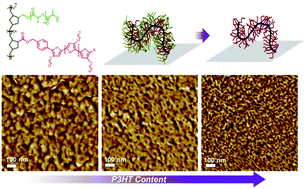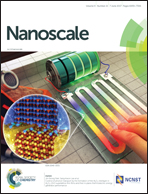Nanoporous poly(3-hexylthiophene) thin film structures from self-organization of a tunable molecular bottlebrush scaffold†
Abstract
The ability to widely tune the design of macromolecular bottlebrushes provides access to self-assembled nanostructures formed by microphase segregation in melt, thin film and solution that depart from structures adopted by simple linear copolymers. A series of random bottlebrush copolymers containing poly(3-hexylthiophene) (P3HT) and poly(D,L-lactide) (PLA) side chains grafted on a poly(norbornene) backbone were synthesized via ring-opening metathesis polymerization (ROMP) using the grafting through approach. P3HT side chains induce a physical aggregation of the bottlebrush copolymers upon solvent removal by vacuum drying, primarily driven by attractive π–π interactions; however, the amount of aggregation can be controlled by adjusting side chain composition or by adding linear P3HT chains to the bottlebrush copolymers. Coarse-grained molecular dynamics simulations reveal that linear P3HT chains preferentially associate with P3HT side chains of bottlebrush copolymers, which tends to reduce the aggregation. The nanoscale morphology of microphase segregated thin films created by casting P3HT–PLA random bottlebrush copolymers is highly dependent on the composition of P3HT and PLA side chains, while domain spacing of nanostructures is mainly determined by the length of the side chains. The selective removal of PLA side chains under alkaline conditions generates nanoporous P3HT structures that can be tuned by manipulating molecular design of the bottlebrush scaffold, which is affected by molecular weight and grafting density of the side chains, and their sequence. The ability to exploit the unusual architecture of bottlebrushes to fabricate tunable nanoporous P3HT thin film structures may be a useful way to design templates for optoelectronic applications or membranes for separations.



 Please wait while we load your content...
Please wait while we load your content...